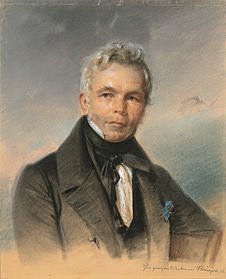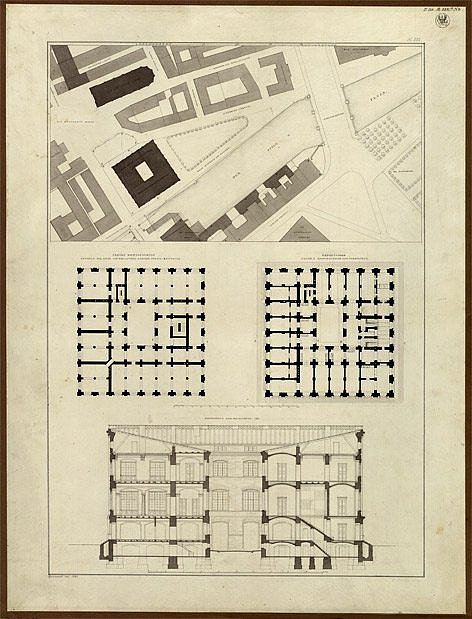Beginning in 2019, the Humboldt Forum will showcase the cultures of the world – but where in Berlin can museum-goers actually experience architecture? The SPK’s president, Hermann Parzinger, makes a plea for the completion of the historical center of Berlin.
When the 175th anniversary of the death of Prussia’s ‘star’ architect, Karl Friedrich Schinkel, was celebrated recently, the spotlight fell yet again on the vacant lot in central Berlin where his building for the Academy of Architecture, the Bauakademie, once stood. The gap is almost painful to see – and when the Berlin City Palace is fully rebuilt, if not sooner, the mock-up of the Academy of Architecture, assembled from tarpaulins and aluminum scaffolding poles, will become even harder to bear.
If there was ever a building in the heart of Berlin that exemplified the architectural modernity and innovative energy of the first half of the nineteenth century, then it was the Academy of Architecture. And if there is one building that deserves to rise again to bear witness to the past in the heart of Berlin, then it is this revolutionary brick structure from 1836.
Schinkel’s Academy of Architecture was the first secular building of note in Prussia to feature exposed brickwork. Its column grid with eight axes in each direction defined a mathematically precise layout, while the themes of its ornamental terracotta panels were more programmatic than merely decorative in their purpose. As a place of education for architects and engineers, it was far ahead of its time: a hotbed of ground-breaking developments in design and construction. The teaching rooms and library on the first and second upper floors were its core facilities, while the shops of the Royal Porcelain Manufactory, the court jeweler, and Gropius art dealers made the ground floor an integral part of life in the city – in just the kind of lively way that we envisage for the Humboldt Forum.
Bombed, partially rebuilt, demolished, replaced, demolished – and now?
Damaged by bombs and burned out in February 1945, the building’s importance meant that after the war it was soon at the focus of the East German government’s plans for reconstruction. The shell was repaired and in 1953 the topping-out ceremony was held. Work on the interior ran into difficulties, however, culminating in a freeze on further building work in 1956.
In 1958, an ideas competition was held to redesign the city center in a socialist style befitting the capital of the German Democratic Republic, and in 1962 the shell was demolished because its character was allegedly too Prussian, despite protests at home and abroad. It was replaced by a new building for the Ministry of Foreign Affairs, which in turn was demolished in 1995-96.
In the meantime, there has been no end of debate about reconstructing the Academy of Architecture. The supporters of this proposal began by forming a Friends’ association and a non-profit construction foundation. In 2001, the "Verein Internationale Bauakademie Berlin" was created on the initiative of the Senate Department for Urban Development and the Stiftung Preussischer Kulturbesitz (Prussian Cultural Heritage Foundation). Up to now, not much has come of all this. A clear signal from the federal government and the state of Berlin is needed if the reconstruction is to happen.
It is now imperative to concentrate our efforts on this project, given that almost ten years have passed since the adjoining Schinkelplatz was recreated according to the historical design. You do not need to have a reconstruction fetish to realize why the Academy of Architecture must be restored to its rightful place, but after that, there is no call for any more dreams of reconstruction.
The Academy of Architecture could house a museum of architecture
This is not merely a matter of recreating a historically significant building. Any reconstruction has to provide clear answers to questions about the sense and purpose of the measure concerned; this also applies – with all due respect – to Schinkel’s Academy of Architecture. There are many ‘nice-to-haves’ here, but the ‘must-have’ is plain to see. It is hard to understand why a city like Berlin, of all places, possesses no first-class museum of architecture. Many visitors to the German capital come here precisely because of Berlin’s important role in the urban planning and architectural developments of the last two hundred years. What other city of this size has re-invented itself so often – over and over again?
Almost every significant and influential architect has left his mark here: from Gily to Stüler, from Wagner to Häring, from Poelzig to Paulick, and from Schultes to Chipperfield. Schinkel’s makeover of the Prussian royal seat with a museum, a concert hall, a guardhouse, a cathedral, and an architectural academy, gave it international standing. His era was followed by an economic boom (Gründerzeit) and subsequent national assertiveness that fuelled the expansion of the city as the capital of the young Empire. The 1920s were typified by housing developments with a focus on functional and social concerns. After this came a series of changes: modernism; the gigantomania of the Nazi period (exemplified by plans to transform Berlin into a world capital called Germania); total destruction in 1945; post-war reconstruction; the rival systems of the East and the West, and finally, after the reunification of the city in 1990, a new urban design plan that aimed for harmony between innovative projects and the selective recovery of the historic built fabric.
What location could be better suited to telling the story of all these different developments than here? Moreover, Berlin boasts several outstanding architectural collections – but they are tucked safely away, out of sight and out of mind. The Stiftung Preussischer Kulturbesitz, for example, possesses architectural collections and the estates of important architects in both the Kunstbibliothek (Art Library) and the Staatsbibliothek (Berlin State Library). To these can be added the collections of the Technische Universität Berlin and institutions such as the Akademie der Künste and the Berlinische Galerie.
Wouldn’t it be fascinating to bring all the treasures of these institutions together in one place at last? In addition, temporary exhibitions with historical or contemporary perspectives could address aspects of architecture and urban planning in Berlin and around the world.
In a democratic society, especially, architecture and urban planning need broad social participation, because the issue at heart is no less than the design of the environment in which we all live. The question is: How do we want to live tomorrow?
Democratic powerhouse in Schinkel’s spirit
Once the Pergamon Museum has been refurbished, it will offer a unique overview of the architectural history of Antiquity, from ancient Egypt and Babylon to early Islam. As for Berlin’s own large urban projects, what better place to contemplate them from than the Academy of Architecture? If its exhibition spaces were augmented with a library and archive floor, including study and research facilities, training and seminar rooms, digital access and virtual presentations, the result would be a Bauakademie 4.0 – a conceptual powerhouse with platforms for display and discussion.
In a democratic society, especially, architecture and urban planning need broad social participation, because the issue at heart is no less than the design of the environment in which we all live. The question is: How do we want to live tomorrow? If it were imbued with a vision of this kind, the reconstruction of the Academy of Architecture would not only reclaim a very special building for the historic center of Berlin. It would also give rise to a center where the fascinating field of architectural design and construction could be considered and experienced afresh, in a spirit inspired by Schinkel.
This article was published in the Tagesspiegel on 11 October 2016.




